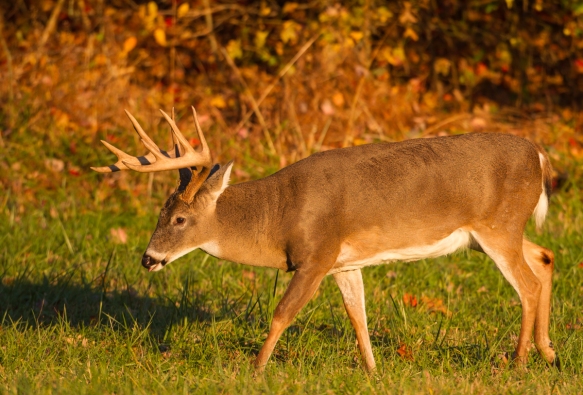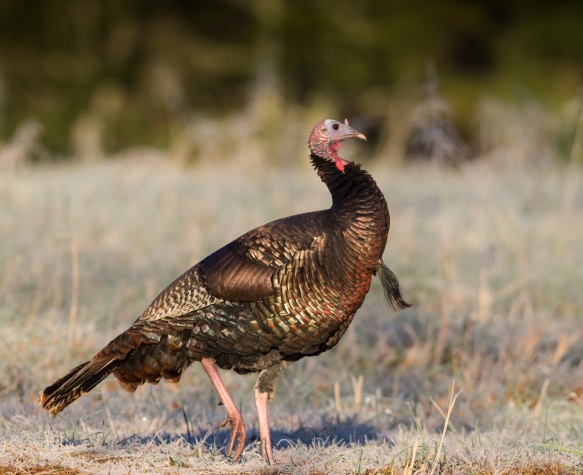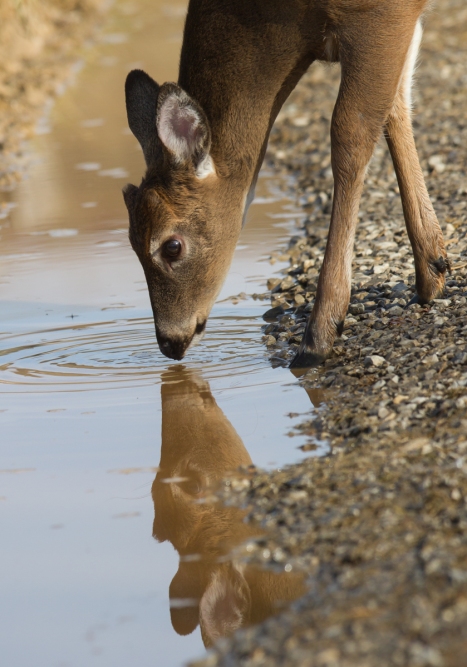Cades Cove is a 6800 acre valley on the Tennessee side of Great Smoky Mountains National Park. It is probably the most visited area of the park and the Smokies are the most visited national park in the United States with more than 9 million visitors each year (Grand Canyon is second with about 4 million). And I can believe that Cades Cove is that popular as each of the four times I have been, it has been crowded. This past week was my first autumn visit and I was expecting fewer people, but I was wrong.
The valley is a beautiful place, especially at sunrise and sunset. There are many short trails, a visitor center, streams, and scenic views. There are also a large number of historic structures from the thriving community that lived in the valley until it became part of the national park in 1934. One reason for its popularity (and the reason for my visit) is its wildlife. Cades Cove is well known for its abundance of species such as White-tailed Deer (especially large bucks), Wild Turkey, and Black Bear. There is easy access provided to the valley via a one way 11-mile loop road. The area offers excellent habitat and relatively easy wildlife viewing with its mix of meadows, managed fields, hardwood forests, and mountain streams.
I arrived late in the afternoon last Thursday and, after hurriedly setting up my tent in the campground, headed out to see what I could find as it was approaching prime wildlife viewing time. A few hundred yards past the entrance to the loop road, I came to a field with several large bucks feeding. There were a few folks out watching so I grabbed the camera and walked out. There were five bucks – two 10-points, one 8-point, and two 6-points, an impressive start.
One thing that is great about Cades Cove is that most of the wildlife is very accustomed to people and so it is a great place to observe behaviors. While the rut is still in progress, I think some of the passions have subsided. But one large buck started thrashing a downed trees’ branches with his antlers and another soon joined him. The larger buck then started licking the antlers of the slightly smaller one, they briefly locked horns for a very passive shove, and then moved off together to feed side-by-side. Two other bucks touched antlers and then brushed noses as if whispering something about one of the other guys in the field.
I finally drove the remainder of the loop road as the sun was setting and looked for places to check the next morning. As I photographed a particularly beautiful tree out in one of the meadows, I heard coyotes yipping a few hundred yards away under the clear, darkening sky. A great ending to my first afternoon in Cades Cove. I awoke about 4 a.m. and headed out into the cold air toward the bathroom when I heard some rustling in the leaves about 20 feet from the tent. In the moonlight, I could see a dark form and my first thought was bear (there are warnings about bear-proofing your campsite). But when I turned on my flashlight it was a Wild Boar, an introduced species that the park is actively trying to control. They grub through the soil looking for whatever they can find to eat and, in doing so, root up large amounts of plants which can damage sensitive habitats. It looks like a small bulldozer has gone through an area after they are finished feeding. The Boar trotted off and I gladly moved off in the other direction.
The next morning there were twenty cars at the entrance to the loop road when the ranger opened the gate at 7 a.m. I drove past the field with all the bucks (and most of the cars) and was soon by myself in the upper end of the valley. A few turkeys flew down from their roost and landed in a nearby field so I stopped to watch. They were picking through the grass for who knows what and then walked over and grabbed a few berries from an American Holly. I had just sat down to photograph them when they started to head my way. I was soon surrounded by turkeys, scratching in the leaves under a nearby Sycamore and pecking at unseen morsels.
As the light started to hit them, their feathers made them shimmer with bronze, green, and rich rust colors.
As beautiful as their feathers are, their heads are a bit on the not-so-beautiful side, especially with the close looks I was getting. They continued to peck and feed, glancing my way occasionally to make sure I had not moved from my cold, sitting position in the icy grass. I sat with them for about twenty minutes until a diesel pickup truck stopped nearby and spooked them.
With the increasing traffic, I decided to hike up into the woods near where I had seen a large buck the afternoon before. On top of the hill, I saw movement just inside the woods. A small 6-point buck was stretching his head up and grabbing something. Only when I later looked at the image could I see he was feeding on Greenbrier berries (Smilax sp.). I have seen them eat the shoots of Smilax, but never the berries before now.
Walking down into the woods I came a cross a small herd of deer, all female. Suddenly they all jerked their heads to the left and stared into the woods at something I could not see. A very large 7-point buck then came into view, chased away the does, and started to feed. I moved one step to the side to get a better view and he spotted me and turned my way with nostrils flared and mouth agape. I interpreted that as a “I could take you but I’m going to let you live” look and I didn’t move again until he nibbled his way off into the forest. Driving back to camp later that day I was happy with the wildlife observations except for one thing – no bears. But I still had one more morning.
The next morning was in the 20’s with another heavy frost. I drove out to the far end of the loop road and was, again, relatively alone as most had stopped at the first field with all the bucks. A lone doe was at the edge of the frozen meadow when I spotted something trailing her – it first appeared as just antlers in very tall grasses and saplings, but then became a large, frosty buck.
His antler spread was impressive as he stared at the disappearing doe. I stayed put and he trotted across the field, pausing once to glance at an oncoming car, before retiring into the edge of the woods.
I hung around watching some turkey and small groups of birds (Eastern Bluebirds, American Goldfinches, American Robins, Golden-crowned Kinglets) as they swept through feeding on whatever they could find in the crisp morning air. But soon, the rising sun melted the frost and warmed the valley so I headed back over to where the buck had vanished. I saw a large buck, which I assume was the same one, although I can’t be sure as it was turned away from me. It started making a scrape, in which the buck paws at the ground, exposing moist soil. After pawing at the ground a few times he urinated in the scrape and then reached up to am overhanging branch and rubbed his head back and forth. This deposits scent on the branch from his head and from glands in the corners of their eyes. The scrape serves as a signal to all other deer of his presence and his status. I don’t know about the other deer, but I was impressed.
I drove on as traffic started to increase hoping to find a bear before I had to break camp and leave. Far out in a meadow I instead spotted three bucks moving in an unusual manner. I pulled over to look and it appeared as if they were in a three-way sparring match, heads down, antlers touching, and slowly spinning in a circle testing each other. I grabbed the camera and headed out, when, of course, they broke apart and started feeding (guess all that testosterone-induced activity makes a guy hungry). They slowly drifted apart as they browsed and I managed a few photos of the largest of the bucks, a compact 8-pointer, as he kept an eye on his departing opponents.
It had been a rewarding couple of days in Cades Cove. My only frustration was the traffic congestion. It was made worse by two things: drivers ignoring the signs saying “no stopping” and “please use pullouts to observe wildlife”; and drivers going half or less of the posted 20 mph speed limit without pulling over to let others pass. I also saw a few visitors get way too close to deer (within feet). This explains the signs that read “Do Not Feed, Touch, or Disturb the Wildlife”. Touch…really, you need a sign for that?
My other disappointment was that for the first time in my four visits to this picturesque valley, I had no bear sightings. I was beginning to think I had lost my bear mojo as I drove out…but, such was not the case. But you’ll have to wait until the next post to see why.
I’ll leave you with a few more images from Cades Cove…





















Wow…. just wow…..
Loved them.